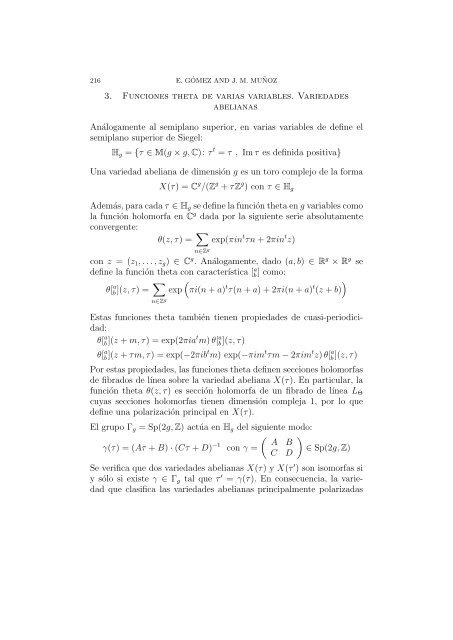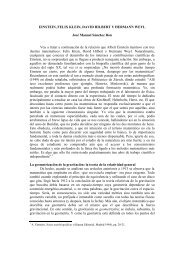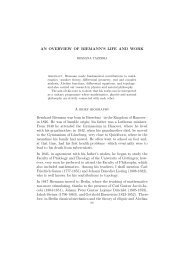FUNCIONES THETA DE RIEMANN 1. Introducción El objetivo de ...
FUNCIONES THETA DE RIEMANN 1. Introducción El objetivo de ...
FUNCIONES THETA DE RIEMANN 1. Introducción El objetivo de ...
You also want an ePaper? Increase the reach of your titles
YUMPU automatically turns print PDFs into web optimized ePapers that Google loves.
216 E. GÓMEZ AND J. M. MUÑOZ<br />
3. Funciones theta <strong>de</strong> varias variables. Varieda<strong>de</strong>s<br />
abelianas<br />
Análogamente al semiplano superior, en varias variables <strong>de</strong> <strong>de</strong>fine el<br />
semiplano superior <strong>de</strong> Siegel:<br />
Hg = {τ ∈ M(g × g, C): τ t = τ , Im τ es <strong>de</strong>finida positiva}<br />
Una variedad abeliana <strong>de</strong> dimensión g es un toro complejo <strong>de</strong> la forma<br />
X(τ) = C g /(Z g + τZ g ) con τ ∈ Hg<br />
A<strong>de</strong>más, para cada τ ∈ Hg se <strong>de</strong>fine la función theta en g variables como<br />
la función holomorfa en Cg dada por la siguiente serie absolutamente<br />
convergente:<br />
θ(z, τ) = <br />
exp(πin t τn + 2πin t z)<br />
n∈Zg con z = (z1, . . . , zg) ∈ Cg . Análogamente, dado (a, b) ∈ Rg × Rg se<br />
<strong>de</strong>fine la función theta con característica [ a b ] como:<br />
θ[ a b](z, τ) = <br />
exp πi(n + a) t τ(n + a) + 2πi(n + a) t <br />
(z + b)<br />
n∈Z g<br />
Estas funciones theta también tienen propieda<strong>de</strong>s <strong>de</strong> cuasi-periodicidad:<br />
θ[ a b](z + m, τ) = exp(2πia t m) θ[ a b](z, τ)<br />
θ[ a b](z + τm, τ) = exp(−2πib t m) exp(−πim t τm − 2πim t z) θ[ a b](z, τ)<br />
Por estas propieda<strong>de</strong>s, las funciones theta <strong>de</strong>finen secciones holomorfas<br />
<strong>de</strong> fibrados <strong>de</strong> línea sobre la variedad abeliana X(τ). En particular, la<br />
función theta θ(z, τ) es sección holomorfa <strong>de</strong> un fibrado <strong>de</strong> línea LΘ<br />
cuyas secciones holomorfas tienen dimensión compleja 1, por lo que<br />
<strong>de</strong>fine una polarización principal en X(τ).<br />
<strong>El</strong> grupo Γg = Sp(2g, Z) actúa en Hg <strong>de</strong>l siguiente modo:<br />
γ(τ) = (Aτ + B) · (Cτ + D) −1 con γ =<br />
A B<br />
C D<br />
<br />
∈ Sp(2g, Z)<br />
Se verifica que dos varieda<strong>de</strong>s abelianas X(τ) y X(τ ′ ) son isomorfas si<br />
y sólo si existe γ ∈ Γg tal que τ ′ = γ(τ). En consecuencia, la variedad<br />
que clasifica las varieda<strong>de</strong>s abelianas principalmente polarizadas










